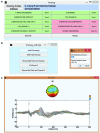TMSEEG: A MATLAB-Based Graphical User Interface for Processing Electrophysiological Signals during Transcranial Magnetic Stimulation
- PMID: 27774054
- PMCID: PMC5054290
- DOI: 10.3389/fncir.2016.00078
TMSEEG: A MATLAB-Based Graphical User Interface for Processing Electrophysiological Signals during Transcranial Magnetic Stimulation
Abstract
Concurrent recording of electroencephalography (EEG) during transcranial magnetic stimulation (TMS) is an emerging and powerful tool for studying brain health and function. Despite a growing interest in adaptation of TMS-EEG across neuroscience disciplines, its widespread utility is limited by signal processing challenges. These challenges arise due to the nature of TMS and the sensitivity of EEG to artifacts that often mask TMS-evoked potentials (TEP)s. With an increase in the complexity of data processing methods and a growing interest in multi-site data integration, analysis of TMS-EEG data requires the development of a standardized method to recover TEPs from various sources of artifacts. This article introduces TMSEEG, an open-source MATLAB application comprised of multiple algorithms organized to facilitate a step-by-step procedure for TMS-EEG signal processing. Using a modular design and interactive graphical user interface (GUI), this toolbox aims to streamline TMS-EEG signal processing for both novice and experienced users. Specifically, TMSEEG provides: (i) targeted removal of TMS-induced and general EEG artifacts; (ii) a step-by-step modular workflow with flexibility to modify existing algorithms and add customized algorithms; (iii) a comprehensive display and quantification of artifacts; (iv) quality control check points with visual feedback of TEPs throughout the data processing workflow; and (v) capability to label and store a database of artifacts. In addition to these features, the software architecture of TMSEEG ensures minimal user effort in initial setup and configuration of parameters for each processing step. This is partly accomplished through a close integration with EEGLAB, a widely used open-source toolbox for EEG signal processing. In this article, we introduce TMSEEG, validate its features and demonstrate its application in extracting TEPs across several single- and multi-pulse TMS protocols. As the first open-source GUI-based pipeline for TMS-EEG signal processing, this toolbox intends to promote the widespread utility and standardization of an emerging technology in brain research.
Keywords: MATLAB toolbox; artifact correction; brain mapping; electroencephalography; independent component analysis; signal processing; standardized workflow; transcranial magnetic stimulation.
Figures














Similar articles
-
Characterizing and Modulating Brain Circuitry through Transcranial Magnetic Stimulation Combined with Electroencephalography.Front Neural Circuits. 2016 Sep 22;10:73. doi: 10.3389/fncir.2016.00073. eCollection 2016. Front Neural Circuits. 2016. PMID: 27713691 Free PMC article. Review.
-
Analysing concurrent transcranial magnetic stimulation and electroencephalographic data: A review and introduction to the open-source TESA software.Neuroimage. 2017 Feb 15;147:934-951. doi: 10.1016/j.neuroimage.2016.10.031. Epub 2016 Oct 20. Neuroimage. 2017. PMID: 27771347 Review.
-
Evaluation of algorithms for correction of transcranial magnetic stimulation-induced artifacts in electroencephalograms.Med Biol Eng Comput. 2019 Dec;57(12):2599-2615. doi: 10.1007/s11517-019-02053-3. Epub 2019 Oct 26. Med Biol Eng Comput. 2019. PMID: 31656029
-
The non-transcranial TMS-evoked potential is an inherent source of ambiguity in TMS-EEG studies.Neuroimage. 2019 Jan 15;185:300-312. doi: 10.1016/j.neuroimage.2018.10.052. Epub 2018 Oct 19. Neuroimage. 2019. PMID: 30347282
-
Recovering TMS-evoked EEG responses masked by muscle artifacts.Neuroimage. 2016 Oct 1;139:157-166. doi: 10.1016/j.neuroimage.2016.05.028. Epub 2016 Jun 9. Neuroimage. 2016. PMID: 27291496
Cited by
-
Reliability and Validity of Transcranial Magnetic Stimulation-Electroencephalography Biomarkers.Biol Psychiatry Cogn Neurosci Neuroimaging. 2023 Aug;8(8):805-814. doi: 10.1016/j.bpsc.2022.12.005. Epub 2022 Dec 17. Biol Psychiatry Cogn Neurosci Neuroimaging. 2023. PMID: 36894435 Free PMC article. Review.
-
Spatiotemporal Dynamics of Single and Paired Pulse TMS-EEG Responses.Brain Topogr. 2020 Jul;33(4):425-437. doi: 10.1007/s10548-020-00773-6. Epub 2020 May 4. Brain Topogr. 2020. PMID: 32367427 Free PMC article.
-
Baseline markers of cortical excitation and inhibition predict response to theta burst stimulation treatment for youth depression.Sci Rep. 2023 Nov 4;13(1):19115. doi: 10.1038/s41598-023-45107-1. Sci Rep. 2023. PMID: 37925557 Free PMC article.
-
A TMS/EEG protocol for the causal assessment of the functions of the oscillatory brain rhythms in perceptual and cognitive processes.STAR Protoc. 2022 Jun 4;3(2):101435. doi: 10.1016/j.xpro.2022.101435. eCollection 2022 Jun 17. STAR Protoc. 2022. PMID: 35677610 Free PMC article.
-
Adaptive Bayesian Spectral Analysis of High-dimensional Nonstationary Time Series.J Comput Graph Stat. 2021;30(3):794-807. doi: 10.1080/10618600.2020.1868305. Epub 2021 Mar 1. J Comput Graph Stat. 2021. PMID: 35936018 Free PMC article.
References
Publication types
MeSH terms
LinkOut - more resources
Full Text Sources
Other Literature Sources
Research Materials

